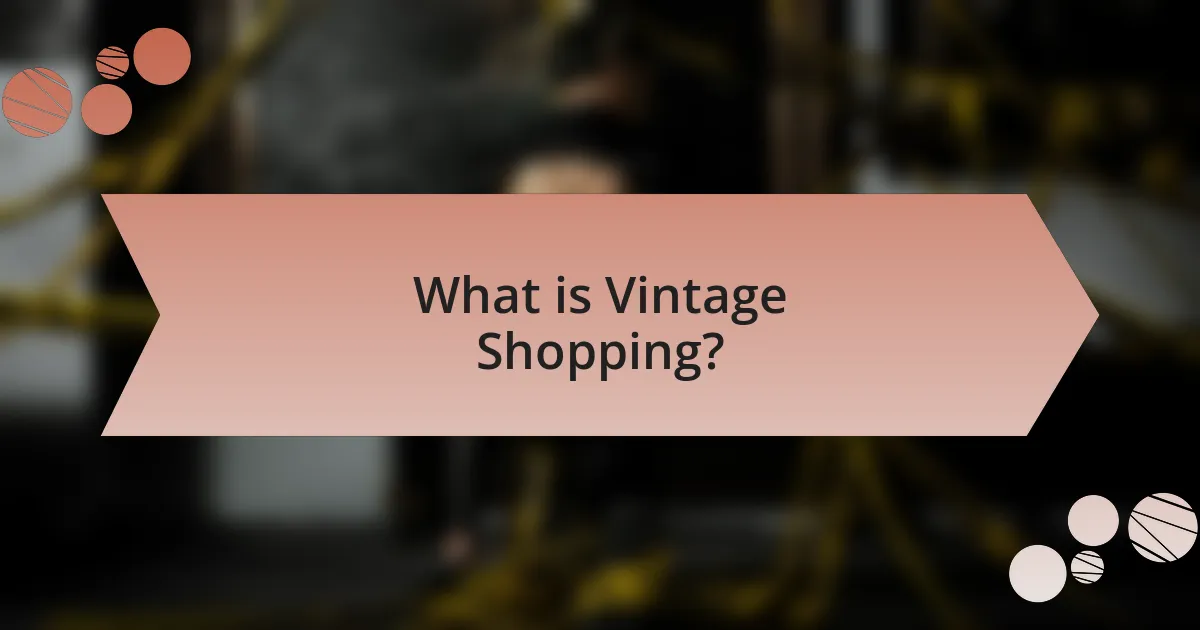Vintage shopping is the practice of purchasing second-hand items, particularly clothing and accessories, that are at least 20 years old, reflecting past styles and trends. This eco-friendly trend promotes sustainability by reducing waste and the demand for new production, while offering unique, high-quality pieces with historical significance. The article explores how vintage shopping differs from regular shopping, defines what constitutes a vintage item, and assesses the quality of vintage goods. It also discusses the growing popularity of vintage shopping driven by cultural shifts towards sustainability, the influence of social media, and the environmental benefits associated with this practice. Additionally, it provides best practices for finding quality vintage items and addresses common challenges faced by vintage shoppers.

What is Vintage Shopping?
Vintage shopping is the practice of purchasing second-hand items, typically clothing and accessories, that are at least 20 years old and reflect the styles and trends of past eras. This shopping method not only promotes sustainability by reducing waste and the demand for new production but also allows individuals to find unique, high-quality pieces that often have a rich history. The vintage market has grown significantly, with reports indicating that the global second-hand apparel market is expected to reach $64 billion by 2024, highlighting its increasing popularity and eco-friendly appeal.
How does Vintage Shopping differ from regular shopping?
Vintage shopping differs from regular shopping primarily in the sourcing and uniqueness of items. Vintage shopping focuses on acquiring second-hand clothing and accessories that are typically at least 20 years old, offering distinctive styles and historical significance that are not found in contemporary retail. Regular shopping, on the other hand, involves purchasing new items from current collections that reflect modern trends. The appeal of vintage shopping lies in its sustainability, as it promotes recycling and reduces waste, contrasting with the fast fashion model that contributes to environmental degradation.
What defines an item as vintage?
An item is defined as vintage if it is at least 20 years old and reflects the style or characteristics of a specific era. This classification is commonly used in fashion, furniture, and collectibles, where items from the mid-20th century, for example, are often sought after for their unique design and historical significance. The vintage label indicates not only age but also a certain quality and desirability that distinguishes these items from contemporary products.
How is the quality of vintage items assessed?
The quality of vintage items is assessed through a combination of factors including condition, authenticity, rarity, and provenance. Condition refers to the physical state of the item, with specific attention to wear, damage, and repairs that may affect its value. Authenticity is verified through documentation or expert appraisal, ensuring the item is genuinely from the claimed era or designer. Rarity increases an item’s desirability, as limited availability often correlates with higher value. Provenance, or the item’s history of ownership, adds context and can significantly enhance its appeal and worth. Collectors and appraisers often utilize these criteria to determine the overall quality and market value of vintage items.
Why is Vintage Shopping gaining popularity?
Vintage shopping is gaining popularity due to its alignment with sustainable fashion practices and the unique, one-of-a-kind items it offers. As consumers become more environmentally conscious, they seek alternatives to fast fashion, which contributes to waste and pollution. According to a 2021 report by ThredUp, the secondhand market is projected to reach $64 billion by 2024, indicating a significant shift in consumer behavior towards sustainable shopping options. This trend is further fueled by the desire for individuality, as vintage pieces often provide distinct styles that are not available in mainstream retail.
What cultural factors contribute to the rise of vintage shopping?
The rise of vintage shopping is primarily driven by a cultural shift towards sustainability and individuality. Consumers increasingly value eco-friendly practices, leading to a preference for second-hand goods that reduce waste and promote recycling. According to a 2021 report by ThredUp, the resale market is projected to reach $64 billion by 2024, indicating a significant trend towards sustainable consumption. Additionally, vintage shopping allows individuals to express their unique style, as vintage items often offer distinct aesthetics not found in contemporary fashion. This combination of environmental consciousness and the desire for personal expression has significantly contributed to the popularity of vintage shopping.
How does social media influence vintage shopping trends?
Social media significantly influences vintage shopping trends by enhancing visibility and accessibility of vintage items. Platforms like Instagram and Pinterest allow users to showcase unique finds, creating a community around vintage fashion that encourages others to explore and purchase similar items. According to a 2021 survey by ThredUp, 60% of consumers reported that social media inspired their interest in secondhand shopping, highlighting the role of influencers and curated feeds in shaping consumer preferences. This trend is further supported by the rise of hashtags like #vintagefashion, which aggregate content and foster a sense of belonging among vintage enthusiasts, ultimately driving demand for vintage products.

What are the environmental benefits of Vintage Shopping?
Vintage shopping significantly reduces environmental impact by promoting the reuse of clothing and goods, which decreases waste and conserves resources. By purchasing second-hand items, consumers help divert textiles from landfills, where they can take years to decompose. According to the Environmental Protection Agency, in 2018, approximately 11.3 million tons of textile waste were generated in the U.S. alone. Additionally, vintage shopping minimizes the demand for new production, which is resource-intensive and often involves harmful practices. The fashion industry is responsible for about 10% of global carbon emissions, and by choosing vintage, shoppers contribute to a reduction in this figure. Thus, vintage shopping not only supports sustainable practices but also plays a crucial role in mitigating environmental degradation.
How does Vintage Shopping promote sustainability?
Vintage shopping promotes sustainability by extending the lifecycle of clothing and reducing waste. By purchasing second-hand items, consumers help decrease the demand for new production, which is resource-intensive and contributes to environmental degradation. According to the Environmental Protection Agency, textile waste accounts for approximately 9.2 million tons in landfills annually, and vintage shopping directly mitigates this issue by reusing existing garments. This practice not only conserves resources but also minimizes the carbon footprint associated with manufacturing new clothing.
What impact does buying vintage have on waste reduction?
Buying vintage significantly reduces waste by extending the lifecycle of clothing and goods, thereby minimizing the demand for new production. The fashion industry is responsible for approximately 10% of global carbon emissions and a substantial amount of textile waste, with around 92 million tons generated annually. By choosing vintage items, consumers help divert these products from landfills and reduce the environmental impact associated with manufacturing new items, which includes resource extraction, water usage, and pollution. Studies indicate that purchasing second-hand clothing can reduce carbon emissions by up to 73% compared to buying new garments.
How does Vintage Shopping support ethical consumerism?
Vintage shopping supports ethical consumerism by promoting the reuse of clothing and reducing waste. This practice extends the lifecycle of garments, which helps to minimize the environmental impact associated with fast fashion, where the production of new clothing contributes to pollution and resource depletion. According to a report by the Ellen MacArthur Foundation, the fashion industry is responsible for 10% of global carbon emissions, highlighting the importance of sustainable alternatives like vintage shopping. By choosing vintage items, consumers actively participate in a circular economy, which emphasizes sustainability and ethical consumption.
Why should you consider Vintage Shopping as an eco-friendly option?
Vintage shopping is an eco-friendly option because it promotes sustainability by reducing waste and minimizing the demand for new clothing production. By purchasing second-hand items, consumers help extend the lifecycle of garments, which significantly lowers the environmental impact associated with manufacturing, such as water usage and carbon emissions. According to the Environmental Protection Agency, the fashion industry is responsible for about 10% of global carbon emissions, and vintage shopping directly counters this by reusing existing resources rather than contributing to the fast fashion cycle.
What are the carbon footprint implications of new clothing production?
The carbon footprint implications of new clothing production are significant, contributing approximately 2.1 billion metric tons of greenhouse gas emissions annually. This figure represents around 10% of global carbon emissions, primarily due to energy-intensive processes involved in manufacturing, dyeing, and transporting garments. For instance, the production of a single cotton t-shirt can generate about 2.1 kilograms of CO2 emissions, while synthetic fibers like polyester can have an even higher impact due to their reliance on fossil fuels. Additionally, the fast fashion model exacerbates these emissions by promoting rapid production cycles and increased consumption, leading to higher overall environmental costs.
How does Vintage Shopping contribute to a circular economy?
Vintage shopping contributes to a circular economy by promoting the reuse and recycling of clothing, thereby extending the lifecycle of garments. This practice reduces waste and minimizes the demand for new production, which is resource-intensive and environmentally damaging. According to a report by the Ellen MacArthur Foundation, the fashion industry is responsible for 92 million tons of waste annually, and vintage shopping helps mitigate this by keeping items in circulation longer. By purchasing second-hand items, consumers actively participate in a system that values sustainability and resource conservation, aligning with the principles of a circular economy.

What are the best practices for Vintage Shopping?
The best practices for vintage shopping include researching the history and value of items, inspecting clothing for quality and authenticity, and understanding the fit and style of vintage pieces. Researching helps shoppers identify reputable brands and understand market trends, which can enhance the shopping experience. Inspecting items ensures that they are in good condition, as vintage clothing may have wear and tear; checking seams, zippers, and fabric integrity is crucial. Understanding fit is essential because vintage sizing often differs from modern standards, making it important to try items on or measure them accurately. These practices enhance the likelihood of finding valuable and wearable vintage pieces, contributing to a sustainable fashion choice.
How can you effectively find quality vintage items?
To effectively find quality vintage items, focus on researching reputable vintage shops, online marketplaces, and estate sales. Reputable vintage shops often curate their collections, ensuring higher quality and authenticity, while online marketplaces like Etsy and eBay provide access to a wider range of items, including user reviews that can indicate quality. Estate sales frequently offer unique vintage finds at competitive prices, and attending these sales can lead to discovering rare items. According to a 2021 survey by ThredUp, 70% of consumers are interested in purchasing secondhand items, highlighting the growing trend and availability of quality vintage goods.
What tips should you follow when browsing vintage stores?
When browsing vintage stores, prioritize patience and thoroughness to find unique items. Vintage shopping requires time to sift through various pieces, as treasures are often hidden among less desirable items. Additionally, familiarize yourself with the store’s layout and inventory, as this knowledge can help you navigate effectively and spot valuable finds. Understanding the quality and era of vintage items enhances your ability to make informed purchases, ensuring you select pieces that are both stylish and durable.
How can you identify authentic vintage pieces?
To identify authentic vintage pieces, examine the item’s construction, labels, and materials. Authentic vintage items typically feature high-quality craftsmanship, such as hand-stitched seams and durable fabrics, which were more common before mass production became prevalent in the late 20th century. Additionally, labels can provide crucial information; for instance, vintage clothing often has tags that reflect the brand’s original design era, such as specific logos or care instructions that were used during that time. Furthermore, understanding the historical context of the item, including its style and trends, can help verify its authenticity. For example, a piece from the 1960s may have distinct design elements that differ from contemporary styles, such as bold patterns or specific cuts.
What are the common challenges in Vintage Shopping?
Common challenges in vintage shopping include limited availability, sizing inconsistencies, and potential quality issues. Limited availability arises because vintage items are often one-of-a-kind, making it difficult to find specific pieces. Sizing inconsistencies occur due to changes in sizing standards over the decades, which can lead to difficulties in finding items that fit properly. Additionally, potential quality issues may arise from wear and tear, as vintage items may not always be in pristine condition. These challenges can complicate the vintage shopping experience, requiring shoppers to invest time and effort to find suitable items.
How can you overcome sizing issues with vintage clothing?
To overcome sizing issues with vintage clothing, consider alterations and custom tailoring. Vintage sizes often differ from modern sizing standards, so purchasing items slightly larger allows for adjustments. According to a study by the Fashion Institute of Technology, vintage garments can vary significantly in measurements, making it essential to try items on or check specific measurements before buying. Additionally, using a skilled tailor can help achieve a perfect fit, ensuring that vintage pieces are wearable and flattering.
What should you do if you find damaged vintage items?
If you find damaged vintage items, you should assess the extent of the damage and determine if they can be repaired or restored. Many vintage items, especially furniture and clothing, can often be fixed by professionals or through DIY methods, which can enhance their value and usability. For instance, a study by the National Trust for Historic Preservation indicates that restoration can increase the longevity of vintage items, preserving their historical significance and aesthetic appeal. If the damage is beyond repair, consider repurposing the item creatively or donating it to organizations that specialize in upcycling.
What are some tips for incorporating vintage pieces into your wardrobe?
To effectively incorporate vintage pieces into your wardrobe, start by selecting items that resonate with your personal style and can be easily integrated with modern clothing. Mixing vintage with contemporary pieces creates a balanced look; for example, pairing a vintage blouse with tailored jeans or a modern skirt can enhance your outfit’s uniqueness. Additionally, consider the fit and condition of vintage items, as tailoring can help achieve a more flattering silhouette. Researching fashion eras can also guide your choices, ensuring that the vintage pieces you select align with current trends while maintaining their timeless appeal.
